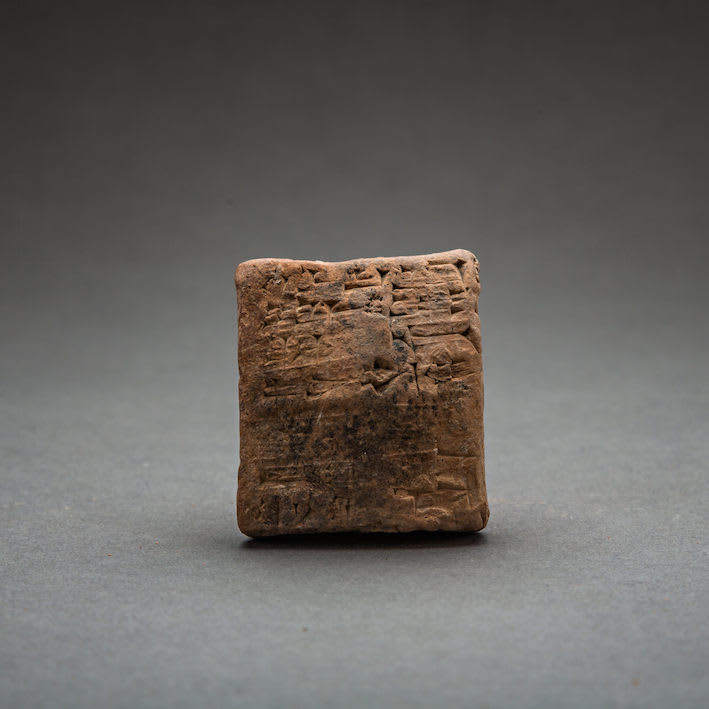Sumerian Cuneiform Terracotta Tablet, 2036 BCE
Terracotta
4 x 4.6 cm
1 5/8 x 1 3/4 in
1 5/8 x 1 3/4 in
LSO.109
Sumerian cuneiform is one of the earliest known forms of written expression. First appearing in the 4th millennium BC in what is now Iraq, it was dubbed cuneiform (‘wedge-shaped’) because...
Sumerian cuneiform is one of the earliest known forms of written expression. First appearing in the 4th millennium BC in what is now Iraq, it was dubbed cuneiform (‘wedge-shaped’) because of the distinctive wedge form of the letters, created by pressing a reed stylus into wet clay. Early Sumerian writings were essentially pictograms, which became simplified in the early and mid 3rd millennium BC to a series of strokes, along with a commensurate reduction in the number of discrete signs used (from c.1500 to 600). The script system had a very long life, and was used by the Sumerians as well as numerous later groups – notably the Assyrians, Elamites, Akkadians and Hittites – for around three thousand years. Certain signs and phonetic standards live on in modern languages of the Middle and Far East, but the writing system is essentially extinct. It was therefore cause for great excitement when the ‘code’ of ancient cuneiform was cracked by a group of English, French and German Assyriologists and philologists in the mid 19th century AD. This opened up a vital source of information about these ancient groups that could not have been obtained in any other way. Cuneiform was used on monuments dedicated to heroic – and usually royal – individuals, but perhaps it’s most important function was that of record keeping. The palace-based society at Ur and other large urban centres was accompanied by a remarkably complex and multifaceted bureaucracy, which was run by professional administrators and a priestly class, all of whom were answerable to central court control. Most of what we know about the way the culture was run and administered comes from cuneiform tablets, which record the everyday running of the temple and palace complexes in minute detail, as in the present case. The Barakat Gallery has secured the services of Professor Lambert (University of Birmingham), a renowned expert in decipherment and translation of cuneiform, to examine and process the information on these tablets. His analysis is presented below: Clay tablet, 46 x 40 mm, with 13 lines of Sumerian cuneiform on obverse and reverse. All surfaces rolled with the scribe’s cylinder seal. Condition good. An administrative document from the period of the third dynasty of Ur, dated to a month so far not identified within a 12-month calendar, and to the 7th year of Amar-Sin, third king of the dynasty, c. 2036 BC.
Translation:
11 male dog 1 female dog: 2 sila of bread eac Their bread: 24 sil Their bread for 30 day Total: 2 gur 120 sila of bread.
Food for the temple dog Ikum-Meshar, keeper of the dogs, received.
His foreman: Ur-……
Disbursement: month Nige…g Year: Huhnuri was destroye A very unusual content, showing that temples employed and fed dogs with bread. Presumably any other food they found for themselves by scavenging. The proportion of dogs and bitches shows a desire not to have too many puppies! A sila is about .85 of a litre, so quite a large amount of bread was used in this way. A gur was 300 sila, so the arithmetic is correct. It is just possible to see much of the seal design on the sides of the tablet: a seated deity on the right, raising one hand, facing is a standing introducing goddess holding up one hand, and on the left a standing figure: the ancient seal owner. There is an astral disc in the sky.
Translation:
11 male dog 1 female dog: 2 sila of bread eac Their bread: 24 sil Their bread for 30 day Total: 2 gur 120 sila of bread.
Food for the temple dog Ikum-Meshar, keeper of the dogs, received.
His foreman: Ur-……
Disbursement: month Nige…g Year: Huhnuri was destroye A very unusual content, showing that temples employed and fed dogs with bread. Presumably any other food they found for themselves by scavenging. The proportion of dogs and bitches shows a desire not to have too many puppies! A sila is about .85 of a litre, so quite a large amount of bread was used in this way. A gur was 300 sila, so the arithmetic is correct. It is just possible to see much of the seal design on the sides of the tablet: a seated deity on the right, raising one hand, facing is a standing introducing goddess holding up one hand, and on the left a standing figure: the ancient seal owner. There is an astral disc in the sky.
